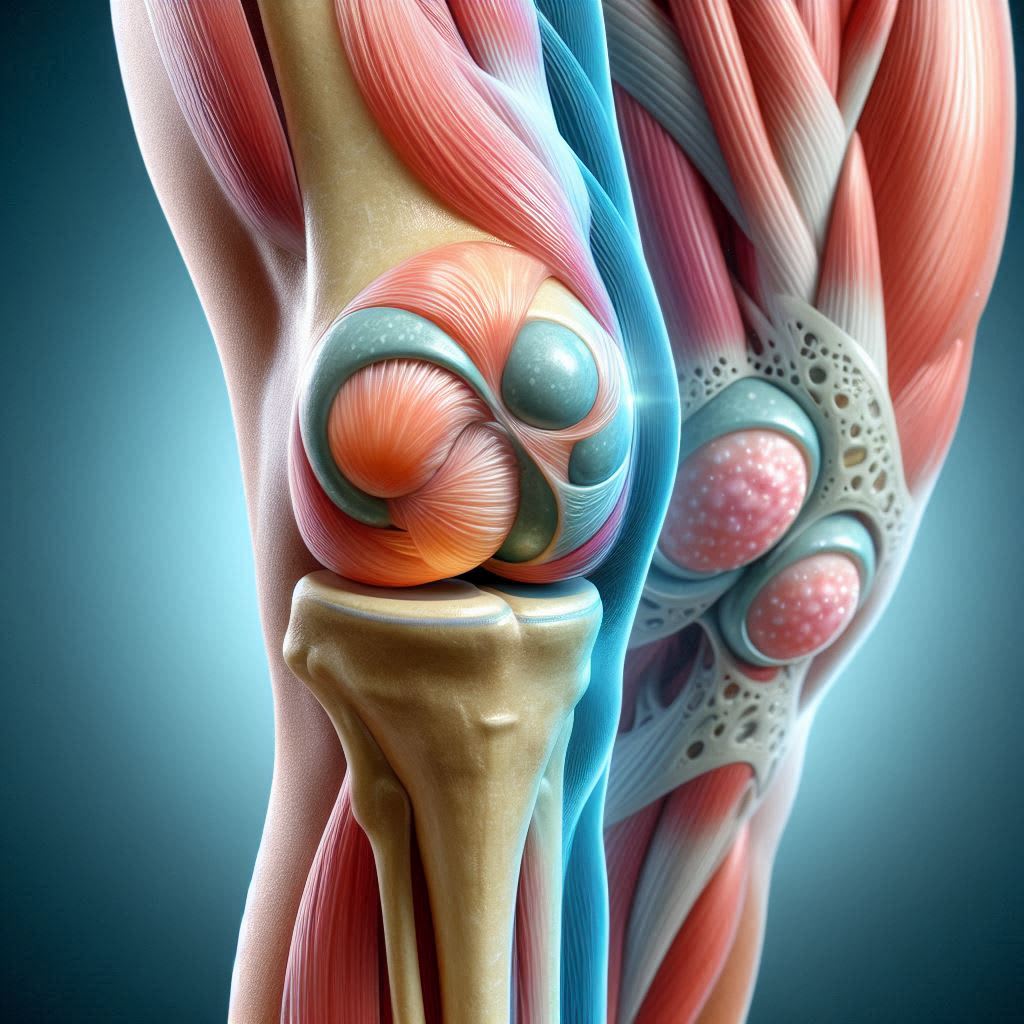Beyond Skin Deep: Unveiling the Wonders of Your Hidden Ecosystem - Cartilage
A Deep Dive into This Essential Tissue, from Structure and Function to Cutting-Edge Strategies for Optimal Joint Health

Beyond Skin Deep: Unveiling the Wonders of Your Hidden Ecosystem - Cartilage
Have you ever marveled at the silent symphony of movement your body performs every day? From the effortless bend of your elbow to the complex mechanics of a walk, a hidden hero plays a vital role - cartilage. Often overshadowed by its more rigid companion, bone, this remarkable living tissue acts as the silent maestro of our musculoskeletal system. Let's delve into the fascinating world of cartilage, exploring its structure, functions, and the cutting-edge science working to keep it healthy.
Why Should You Care About Cartilage?
Imagine your body as a finely tuned machine. Cartilage acts as the shock absorbers in your joints, cushioning the ends of bones and preventing them from grinding against each other with every step. But its brilliance extends beyond mechanics. Cartilage provides structural support for your airways, allowing you to breathe freely. During development, it serves as a blueprint for bone formation, ensuring your skeleton grows strong and resilient.
A Glimpse Inside: The Structure of a Hidden Ecosystem
Cartilage may seem simple, but it's a meticulously designed ecosystem with distinct components working in harmony. Here's a peek inside:
- The Chondrocyte Powerhouse: These specialized cells are the architects of cartilage. They produce the extracellular matrix, the tissue's "ground substance," which gives cartilage its unique properties.
- The Extracellular Matrix - A Gel-like Marvel: This intricate network consists of water, proteoglycans (like aggrecan), and collagen fibers. Aggrecan acts like a sponge, attracting water and creating a gel-like cushion that absorbs shock and distributes pressure evenly within the joint. Imagine tiny water balloons nestled within a web of collagen fibers – this ingenious design allows your joints to move smoothly with minimal friction.
- The Perichondrium - A Protective Shell: Surrounding most cartilage is a fibrous sheath called the perichondrium. This layer nourishes the outer layer of cartilage cells and contributes to its growth and repair. However, unlike bone, cartilage lacks a direct blood supply, making repair a slower process.
The Three Faces of Cartilage: A Diverse Cast of Characters
Cartilage isn't a one-size-fits-all tissue. Depending on its location and function, it takes on three distinct forms:
- Hyaline Cartilage: The most abundant type, hyaline cartilage is smooth and glassy. It coats the ends of bones in synovial joints (like your knees and elbows), forming a low-friction surface for movement. Additionally, hyaline cartilage forms the structure of your nose, trachea, and ribs, providing crucial support without compromising flexibility.
- Elastic Cartilage: As the name suggests, elastic cartilage provides flexibility and resilience. Imagine the springiness of your outer ear – that's the magic of elastic cartilage! It also forms part of your larynx, aiding in speech by allowing the vocal cords to vibrate freely.
- Fibrocartilage: The toughest of the bunch, fibrocartilage is a hybrid, combining the flexibility of elastic fibers with the strength of collagen. It forms the intervertebral discs in your spine, acting as shock absorbers between your vertebrae. Fibrocartilage also strengthens the connection between bones and tendons, ensuring stability and efficient force transmission during movement.
The Delicate Balance: Cartilage Repair and Challenges
Cartilage has a remarkable ability to self-repair, but due to its avascular nature (lacking blood vessels), the process is slow. Injuries or conditions like osteoarthritis, where cartilage breaks down, can be debilitating. Recent advancements in regenerative medicine offer promising solutions. Techniques like stem cell therapy are being explored to promote cartilage repair and regeneration, potentially offering a future where damaged cartilage can be rejuvenated.
The Microbiome Connection: A New Frontier in Cartilage Health
Just like the gut, recent research suggests the presence of a unique microbiome within cartilage. These trillions of microbes might influence its health and contribute to diseases like osteoarthritis. Understanding the role of the microbiome in cartilage could lead to the development of innovative treatments that target this hidden ecosystem.
Cartilage: A Story Yet to be Fully Unfolded
While we've come a long way in understanding cartilage, exciting research continues to unravel its secrets. Scientists are exploring the potential of gene therapy to modify genes responsible for cartilage breakdown. Additionally, the field of bioprinting holds promise for creating artificial cartilage grafts, potentially revolutionizing the treatment of joint injuries.
Beyond the Text: Engaging with Cartilage Health
This exploration of cartilage highlights the importance of taking care of this vital tissue. Here are some ways to keep your cartilage healthy:
- Maintain a Healthy Weight: Excess weight puts undue stress on your joints, accelerating cartilage breakdown. Aim for a healthy weight through balanced diet and regular exercise.
- Move Your Body: Regular physical activity strengthens the muscles surrounding your joints, improving stability and reducing stress on cartilage. Low-impact exercises like swimming, cycling, and walking are excellent choices for joint health.
- Fuel Your Body Right: Include plenty of fruits, vegetables, and whole grains in your diet. These foods are rich in antioxidants and essential nutrients that support cartilage health. Additionally, consider incorporating omega-3 fatty acids found in fatty fish, which have anti-inflammatory properties that may benefit joints.
- Listen to Your Body: Pay attention to any pain or discomfort in your joints. Don't push through pain, as it might indicate an underlying issue. Rest when needed and consult a healthcare professional if pain persists.
- Strength Training: Building strong muscles helps improve joint stability and reduce the risk of injuries that could damage cartilage. Consider incorporating strength training exercises into your routine, focusing on major muscle groups that support your joints.
- Interactive Challenge: Test Your Cartilage Knowledge!
Ready to test your newfound knowledge of cartilage? Take this quick quiz to see how well you understand this fascinating tissue:
[Insert a short, engaging quiz here. The quiz could test readers' knowledge on the different types of cartilage, their functions, or common cartilage-related conditions.]
The Future of Cartilage Research: A Glimpse into Tomorrow
The future of cartilage research is brimming with exciting possibilities. Here are a few areas where scientists are making significant strides:
- Personalized Medicine: Advancements in genetic testing may pave the way for personalized medicine approaches to cartilage health. By identifying individuals at risk for cartilage breakdown based on their genetic makeup, preventative measures and targeted treatments can be implemented.
- Exosomes: These tiny, membrane-bound vesicles hold immense potential for cartilage regeneration. Research is ongoing to explore how exosomes derived from stem cells or healthy cartilage can be used to promote cartilage repair.
- Biomaterials and Scaffolds: Scientists are developing innovative biomaterials and scaffolds that mimic the natural structure of cartilage. These advancements could provide a supportive framework for cell growth, facilitating cartilage regeneration in damaged areas.
Conclusion: Empowering Yourself for a Life in Motion
By understanding the remarkable world of cartilage and implementing these strategies, you can empower yourself to maintain healthy joints and an active lifestyle. Remember, cartilage is a vital component of your musculoskeletal system, and taking care of it is an investment in your mobility and well-being for years to come. Embrace the fascinating world within your body and move with confidence, knowing that you're taking care of your hidden ecosystem – your cartilage.
About the Creator
suren arju
Hi there! I'm Suren, your startup guide. Entrepreneur, writer, dreamer - I share insights, tips & stories to fuel your startup journey. Ready to explore, learn & win together? Join me & let's redefine how we launch, learn & leap!
Enjoyed the story? Support the Creator.
Subscribe for free to receive all their stories in your feed. You could also pledge your support or give them a one-off tip, letting them know you appreciate their work.





Comments
There are no comments for this story
Be the first to respond and start the conversation.